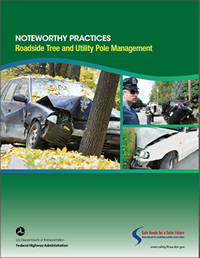
Notice
This document is disseminated under the sponsorship of the U.S. Department of Transportation in the interest of information exchange. The U.S. Government assumes no liability for the use of the information contained in this document. The U.S. Government does not endorse products or manufacturers. Trademarks or manufacturers' names appear in this report only because they are considered essential to the objective of the document.
Quality Assurance Statement
The Federal Highway Administration (FHWA) provides high-quality information to serve Government, industry, and the public in a manner that promotes public understanding. Standards and policies are used to ensure and maximize the quality, objectivity, utility, and integrity of its information. FHWA periodically reviews quality issues and adjusts its programs and processes to ensure continuous quality improvement.
Technical Documentation Page
|
1. Report No. FHWA-SA-16-043 |
2. Government Accession No. |
3. Recipient's Catalog No. |
|||
|
4. Title and Subtitle Noteworthy Practices: Roadside Tree and Utility Pole Management |
5. Report Date September 2016 |
||||
|
6. Performing Organization Code |
|||||
|
7. Authors Joseph G. Jones, P.E. |
8. Performing Organization Report No. |
||||
|
9. Performing Organization Name and Address Leidos |
10. Work Unit No. |
||||
|
11. Contract or Grant No. DTFH61-10-D-00024 |
|||||
|
12. Sponsoring Agency Name and Address Federal Highway Administration Office of Safety |
13. Type of Report and Period Covered Noteworthy Practices Guide July 2015 to September il 2016
|
||||
|
14. Sponsoring Agency Code FHWA |
|||||
|
15. Supplementary Notes: Joseph Cheung (joseph.cheung@dot.gov), Office of Safety (http://www.fhwa.dot. gov/safety), served as the Technical Manager for the Federal Highway Administration (FHWA). The following FHWA staff members contributed as technical working group members, reviewers and/or provided input or feedback to the project at various stages: Frank Julian, Richard Albin, and Nicholas Artimovich. Additionally, many individual safety partners representing States and public private partnerships made significant contributions to this project: special thanks to Timothy Barnett (Alabama DOT); Jennene Ring, Ahmer Nizam, and John Milton (Washington State DOT); Jason Herschock (Pennsylvania DOT); Brian Hurst, and Brandon Darks (Tennessee DOT); Phil Tenhulzen (Nebraska DOR); Tracie Leix, Steve Shaughnessy, and Lynette Firman (Michigan DOT); Brian Hovanec, Mark Thomas, and Heath Patterson (Mississippi DOT); James Marino (Arizona DOT); Stephen Tartre (Main Turnpike Authority); and Charles Muller (Wyoming DOT). |
|||||
|
16. Abstract Crashes involving roadside trees and utility poles are the most prevalent among fatal, run-off-road, fixed object crashes. Nevertheless, these two obstacles remain among the least-treated on the roadside. As such, comprehensive research is both needed and frequently proposed in this area. This report is intended to provide agencies with examples of successful—immediately deployable— tree and pole practices until such time as this research can be performed. These practices range from complex, multi-million dollar contract solutions to in-house efforts that can be accomplished with minimal resources, and have been drawn from every region of the United States as well as from previous research. |
|||||
|
17. Key Words Fixed object, Roadside, Roadway Departure, Severity, Tree, |
18. Distribution Statement No restrictions. |
||||
|
19. Security Classif. (of this report) Unclassified |
20. Security Classif. (of this page) Unclassified |
21. No. of Pages: 32 |
22. Price N/A |
||
Form DOT F 1700.7 (8-72) Reproduction of completed pages authorized
